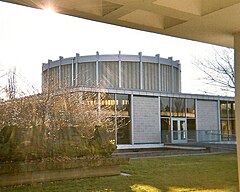Eugene City Hall
| Eugene City Hall | |
|---|---|

City Hall before sunset
|
|
| Alternative names | Civic Center |
| General information | |
| Type | Municipal |
| Architectural style | Modernism |
| Address | 777 Pearl Street |
| Town or city | Eugene, Oregon |
| Country | United States |
| Coordinates | 44°03′05″N 123°05′20″W / 44.051505°N 123.088933°WCoordinates: 44°03′05″N 123°05′20″W / 44.051505°N 123.088933°W |
| Construction started | 1962 |
| Completed | 1964 |
| Demolished | 2014–15 |
| Cost | $2,000,000 |
| Technical details | |
| Floor count | 1 |
| Floor area | 84,000 sq ft (7,800 m2) |
| Design and construction | |
| Architecture firm | Stafford, Morin, and Longwood |
| Structural engineer | W. W. Wilson |
| Main contractor | Gale M. Roberts Co. |
| Website | |
| http://www.eugene-or.gov/index.aspx?nid=668 | |
Eugene City Hall, also known as the Civic Center, was the city hall of Eugene, Oregon, United States, the second-largest city in Oregon, from 1964 to 2012. It was a mid-century modern, single-story structure with a central plaza and underground parking. It was opened in 1964, closed in 2012, and demolished in 2014–15, with plans for its replacement by a new city hall.
The building was the result of a national design contest that included 25 entries, later narrowed to four, and awarded to Stafford, Morin, and Longwood of Eugene and Portland in 1961. Site work began in early 1962. The building opened in 1964. The building and its landscaped plaza were immediately praised as low-key, open designs that welcomed public participation in government. In 1965, it was awarded a citation for excellence in community architecture by the Southwest Oregon chapter of the American Institute of Architects.
As Eugene grew in population and as building codes changed, it became apparent that City Hall did not meet the needs of local government. The 84,000-square-foot (7,800 m2) building had become too small to house the many government departments and personnel, and city planners acquired office space in various nearby locations. City Hall relied upon steam heat provided by the Eugene Water and Electric Board, and when EWEB announced that it would no longer supply steam to downtown Eugene, the building's energy inefficiencies became obvious. Most troublesome to engineers, however, was that the building would not be structurally sound in an earthquake and could collapse into the lower-level parking area. Gradually, all city offices were moved, and the building was abandoned in 2012.
An ongoing discussion began in the late 1990s about whether to demolish City Hall or to remodel it, and should City Hall remain on its present site or move. A 2007 City Hall Complex Master Plan identified a timeline that included Phase Four Design and Construction of a new building by 2011. Police were relocated outside of downtown, but no action was taken on City Hall.
In January 2013, the Eugene City Council voted to construct a new city hall rather than renovate the existing building. The old building was razed in 2014–15, following the adoption of plans to construct a new 25,000-square-foot (2,300 m2) in its place. Demolition began in September 2014 and was completed around June 2015.
...
Wikipedia
